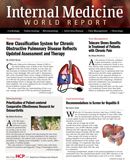Publication
Article
Internal Medicine World Report
Analyzing Antimicrobial Resistance of C. difficile Isolates
Author(s):
Although ribotype 027 remains a significant cause of C. difficile infection, other strain types are gaining in prevalence, according to a study published in Antimicrobial Agents and Chemotherapy.

Although ribotype 027 remains a significant cause of C. difficile infection (CDI), other strain types are gaining in prevalence, according to a study published in Antimicrobial Agents and Chemotherapy.
Ribotype 027 is known to cause severe and complicated infections. Not only is the strain highly resistant to the antibiotics moxifloxacin and clindamycin, but it is also showing reduced sensitivity to vancomycin.
Researchers from Cepheid Inc. and Creighton University examined the PCR ribotypes and the antimicrobial susceptibility test (AST) patterns of 508 C. difficile isolates from across the United States. They presented the data in part at the 2013 Interscience Conference on Antimicrobial Agents and Chemotherapy.
Between May 2011 and April 2013, the researchers collected stool samples from 508 patients (180 in the Northeast, 84 in the South, 78 in the Midwest, and 166 in the West) at 32 hospitals. Then, they tested the isolates for susceptibility to 6 antimicrobials: clindamycin, metronidazole, moxifloxacin, rifampin, tetracycline, and vancomycin.
The investigators observed 29 previously defined ribotypes among 83.3% of the total isolates they received. The remaining 16.7% had unnamed patterns. The predominant strain was ribotype 027 and its prevalence was highest in the Northeast (40%) and the South (38.1%). In the West, ribotype 014/020 was the most common strain.
“Of the 29 PCR ribotypes identified, the 027 strain type was the most common (28.1%), although the rates varied by geographic region,” the authors wrote. “Ribotype 014/020 isolates appear to be emerging.”
After testing the isolates, the authors found 36% were resistant to either clindamycin or moxifloxacin. Only 6.7% of the isolates were resistant to tetracycline. And each of the 508 isolates was susceptible to metronidazole.
Ribotype 027 proved the least susceptible with 30.8% of strains resistant to moxifloxacin, clindamycin, and rifampin. The 027 strain was most resistant to moxifloxacin (92.3%).
Compared to a 2008-2009 study, the prevalence of ribotype 027 decreased significantly in the West, but remained unchanged in the Midwest. Meanwhile, ribotype 014/020 increased significantly in both the West and the Midwest, the researchers reported.
One limitation to the study was that the 2008-2009 study to which the researchers compared results was limited to 6 hospitals in the West and Midwest, while the current study included 32 hospitals from across the country. Additionally, different diagnostic procedures at the collaborating hospitals from which the isolates came may have enriched certain strains over the others.
Lastly, this study only represented 43 control strains, but there are currently more than 400 ribotypes described, according to the researchers.
The authors conclude, “…our typing results are similar to results reported from recent studies in the United States and suggest that ribotype 027 remains a significant cause of CDI." They continued, “However, other strain types, particularly ribotype 014/020, are gaining in prevalence.”





